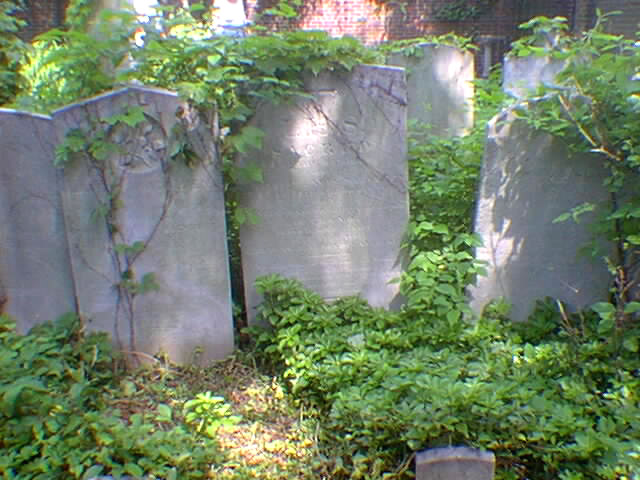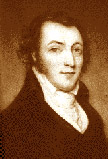
|
The name "MacNeven" appears on Riker Cemetery markers #70 through #77, including the group shown above, among which is marker #75 for a son-in-law of Congressman Samuel Riker, Dr. William James MacNeven (portrait below left), who was
Born March 21, 1763 at Ballynahowna, near Aughrim, County Galway, Ireland, William James's ancestors had been driven by Cromwell from their land holdings in the north of Ireland. His uncle, William O'Kelly MacNeven, was an Irish exile physician who, for his medical skills in service to Empress Maria Theresa had been made an Austrian Baron. Doctor/Baron/Uncle MacNeven sent his nephew aboard for schooling because of anti-Catholic educational restrictions at home. Young MacNeven did his undergraduate studies in Prague and medical studies in Vienna, receiving his degree in 1784. The same year, back in Dublin, a promising medical career opened before him. But involvement in the activities of such Irish revolutionaries as Lord Edward Fitzgerald, Thomas Addis Emmet, and his brother, Robert Emmet, led eventually to his arrest in March, 1798, and confinement -- first in Kilmainham Jail, and afterwards in Fort George, Scotland. Books were MacNeven's own prescription for his retaining mental focus. A classical scholar proficient in various languages, including German, French and Italian, he read continuously, writing commentaries on what he read and even translated books from their original Irish. He is said to have been one of the few leading Irish reformers of his time actually interested in Gaelic culture. In 1802, he was exiled. A year later, young Dr. MacNeven was in Paris trying to gain an interview with Bonaparte to obtain French troops for the Irish cause. Disappointed at not succeeding in that mission, the doctor departed for New York, landing here, according to some reports, on July 4th, 1805.
Dr. MacNeven named to the college's chair of materia medica in 1816. In 1826 he accepted the chair of materia medica at Rutgers Medical College. By the way, this then new medical school was connected to the same educational institution that the year previous had changed its name from Queen's College to Rutgers College to honor American Revolutionary War hero Colonel Henry Rutgers. His support had helped the college survive a financial crisis. Rutgers was a descendant of the same old Dutch family that helped settle New Amsterdam. The original Tombs was built on former Rutgers property. Queen's College aka Rutgers had been founded to help, among other things, train ministers for the Dutch Reformed Church in the colonies. Through marriage, the Rutgers family connects to the Barclays whose names appear on markers #82 and #83 in the Riker Cemetery. MacNevin was said to have been a member of "nearly every society formed in New York having for its object the interests of his countrymen." In 1816 he chaired a committee to aid Irish farmers and farm laborers settling in American lands and he helped set up a NY employment office for Irish emigrants. In 1827 he opened a free registry office for Irish domestic servants. Dr. MacNeven's "Exposition of the Atomic Theory," published in 1820, and his other writings on chemistry received international attention and republication in translation. He regarded as the "Father Of American Chemistry." His "Pieces of Irish History" (published in 1807), and many political writings drew wide interest. He co-edited the "New York Medical and Philosophical Journal" for many years. His interests in Irish continued right up until his death at the age of 78 in the home of his son in law, Thomas Addis Emmet Junior, on July 12th, 1841. . Neither image nor the text above appear in Edgar Alan Nutt's 2004 book. Click Dr. MacNever image to access the Navin ,Nevin , McNevin Irish Family Clan web page that is the source of the portrait and some of the information about him. Click the large image of MacNeven grave markers to access Samuel J. Maguire's detailed account in the .Galway Reader of MacNeven's role in the struggle for Irish freedom. |
Click to return to Part 10 of NYCHS excerpts from Edgar Alan Nutt's book.
